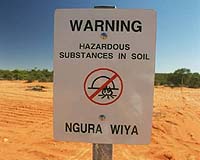
 |
How will "DANGER!" be written 5,000 years from now? How will it be written in 50,000 years?
Finding an answer to these questions may not seem like a Code Red emergency to most people.
But for a growing cadre of scientists, figuring out how to alert our distant descendants to perilous nuclear waste entombed hundreds of metres (feet) below ground has become a fascinating task.
After more than six decades, high-level nuclear detritus is piling up above ground, and governments are starting to spend billions on underground facilities intended to survive tens of thousands and hopefully hundreds of thousands of years.
That means there is an emerging interest in choosing the right signs and language to warn people of a stockpile that could be deadly, as well as a potential source of military nuclear proliferation -- or even a source of fuel, if future technology can recycle it.
Languages evolve fast -- the English of the 11th century bears scant resemblance to the English of the 21st -- and places of human settlement also come and go, shaped by war, climate change and other forces.
Words not only change, they also die out. Today's dead languages include those that, in their halcyon days, belonged to the world's most advanced civilisations.
It took decades to unlock the meaning of Egyptian hieroglyphs only a few thousand years old, and Mayan symbols of even more recent vintage remain a mystery to this day.
So, for humans many generations hence, the major languages, customs and symbols of today may be indecipherable, even though the threat from casks of plutonium- or caesium-tainted waste will still be lethal.
Simply installing a red-lettered sign warning our descendants to steer clear of a deep chamber will not be enough. To those in the future, it might be taken as meaning: "Hey! Dig here! Treasure below!"
Tom Peake of the US Environmental Protection Agency (EPA) says the search for a solution encompasses many areas, including semiotics (the study of signs), linguistics, history and anthropology.
-- 'Installations must not be cut off from society' --
"The need to address the disposal of nuclear waste and its long-term potential hazard has been the impetus for research into long-term memory," he explains.
In the United States, researchers at the Waste Isolation Pilot Plant (WIPP), a nuclear waste dump for the military in the New Mexico desert, envisage crafting gigantic blocks of stone engraved with symbols designed to last for thousands of years.
These will be supported by "information in multiple languages in multiple media" to try to convey the potential danger, said Peake.
In Europe, though, a strong current of thinking is that future waste sites should somehow be integrated into human society so that the warnings are transmitted from generation to generation.
"We must not create installations that are totally cut off from society," Claude Pescatore, a specialist on waste management at the Organisation for Economic Co-operation and Development's (OECD's) Nuclear Energy Agency.
"Disposal facilities can be made part of the fabric of the community rather than operated in isolation from it -- such integration can contribute to, rather than undermine, safety," he said.
He and others argue that civil society should become the cultural custodians of such sites, generating a written and oral tradition to pass along a constant "danger" message in an evolving world.
In this context, France's National Agency for the Management of Nuclear Waste (ANDRA) is experimenting with non-verbal images etched in "permanent" paper designed to last a millennium.
The approach is inspired by the illuminated manuscripts of the Middle Ages, which survived because they were rendered on durable animal-skin parchment and also were an artistic treasure.
"If a document is going to succeed in extending the boundaries of memory, it has to be attractive," explains Patrick Charton, in charge of sustainable development at ANDRA.
For opponents of nuclear energy, the debate on long-term memory is a distraction from the more urgent goal of curbing or halting nuclear development.
As oil prices continue their vertiginous climb, nuclear power is enjoying a renaissance.
But even if the world switched to other forms of energy tomorrow, said Charton, we would still be confronted by the same questions. Storage of highly active, long-term waste is set to start within two decades in at least four countries: the United States, Japan, France and Finland.
"We have to deal with all the radioactive waste that has already been produced -- and that will continue to be produced -- by existing reactors, so the problem of memory is here to stay," said Charton.
Source: SpaceDaily.com